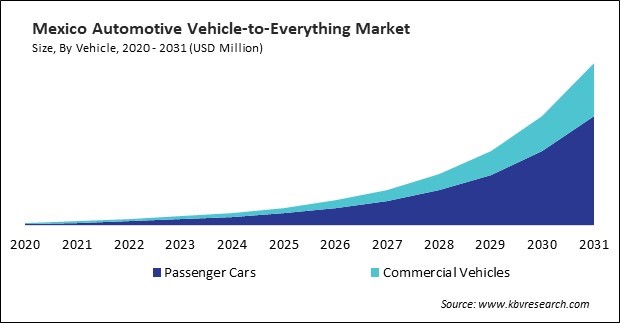The North America Automotive Vehicle-to-Everything Market would witness market growth of 42.3% CAGR during the forecast period (2024-2031).
The US market dominated the North America Automotive Vehicle-to-Everything Market by Country in 2023, and would continue to be a dominant market till 2031; thereby, achieving a market value of $5,563.8 million by 2031. The Canada market is experiencing a CAGR of 45.2% during (2024 - 2031). Additionally, The Mexico market would exhibit a CAGR of 44.2% during (2024 - 2031).

Automotive Vehicle-to-Everything (V2X) is an advanced communication technology that enables vehicles to interact with their surroundings, including other vehicles, infrastructure, pedestrians, and cloud-based networks. This technology enhances road safety, traffic efficiency, and autonomous vehicle performance by facilitating real-time data exchange. By integrating wireless communication systems, such as 5G, Cellular V2X (C-V2X), and Dedicated Short-Range Communication (DSRC), V2X allows vehicles to communicate seamlessly in a connected transportation ecosystem. The automotive vehicle-to-everything market is at the forefront of revolutionizing the transportation industry by enabling seamless communication between vehicles, infrastructure, pedestrians, and networks.
The foundation of V2X lies in its ability to establish a low-latency, high-speed communication network that connects vehicles with various elements of the traffic ecosystem. This includes vehicle-to-vehicle (V2V), vehicle-to-infrastructure (V2I), vehicle-to-pedestrian (V2P), and vehicle-to-network (V2N) communication, each of which plays a unique role in ensuring smoother and safer mobility. V2V enables vehicles to share real-time information about speed, position, and movement, reducing the likelihood of collisions and improving cooperative driving. V2I communication facilitates the interaction between vehicles and traffic signals, road signage, and intelligent transportation systems, thereby promoting effective traffic management and alleviating congestion.
In Mexico, the rapid expansion of V2X adoption drives the demand for robust vehicle-to-vehicle (V2V) and vehicle-to-infrastructure (V2I) communication solutions. Mexico's automotive industry, a key contributor to the national economy, is adapting to the growing demand for V2X-enabled vehicles while addressing security concerns. According to the International Trade Administration (ITA), Mexico is the world’s seventh-largest passenger vehicle manufacturer, producing 3.5 million vehicles annually. Hence, as V2X technology becomes a crucial component of next-generation transportation, North America is set to witness continued investment, infrastructure development, and regulatory advancements to ensure the safety, efficiency, and reliability of V2X communication across the region.
Free Valuable Insights: The Automotive Vehicle-to-Everything Market is Predict to reach USD 26.67 Billion by 2031, at a CAGR of 42.6%
Based on Device, the market is segmented into Onboard Unit and Roadside Unit. Based on Connectivity, the market is segmented into Cellular and DSRC. Based on Vehicle, the market is segmented into Passenger Cars and Commercial Vehicles. Based on Communication, the market is segmented into Vehicle-to-Vehicle (V2V), Vehicle-to-Infrastructure (V2I), Vehicle-to-Pedestrian (V2P), Vehicle-to-Network (V2N), Vehicle-to-Home (V2H), and Vehicle-to-Grid (V2G). Based on countries, the market is segmented into U.S., Mexico, Canada, and Rest of North America.
By Device
By Connectivity
By Vehicle
By Communication
By Country
Our team of dedicated experts can provide you with attractive expansion opportunities for your business.

